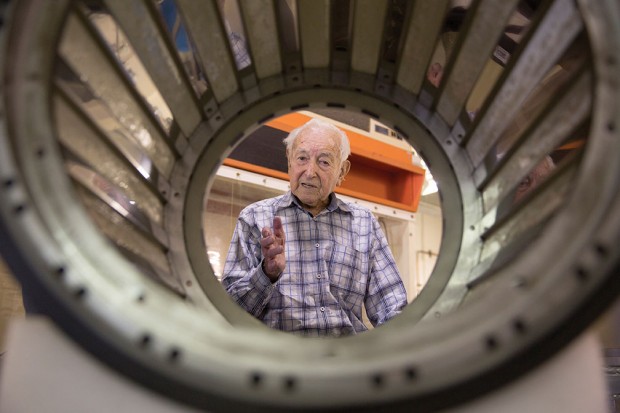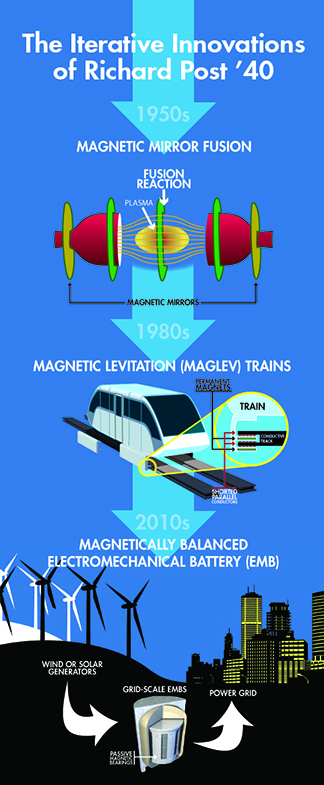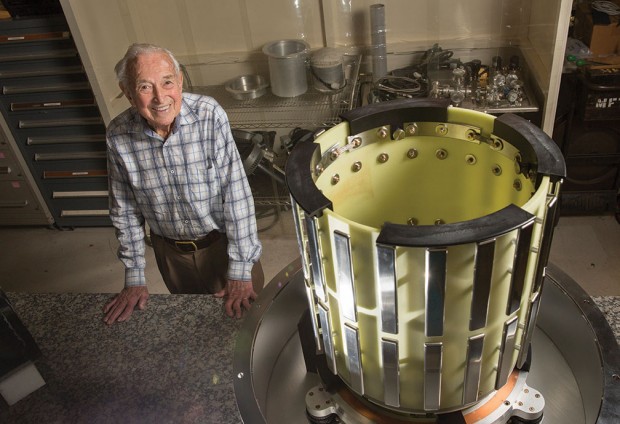
REMEMBER THE U.S. ARMY commercials from the 1980s? A voice intones: “We do more before 9 a.m. than most people do all day.” If Mad Men’s Don Draper were to coin a catchphrase for Dick Post, it would read: “He’s made more discoveries after age 90 than most scientists do in their careers.”
For more than six decades, Richard F. Post ’40 has dedicated his life to solving energy challenges. “My whole career has been shaped by energy,” he says. An applied physicist at Lawrence Livermore National Laboratory (LLNL), Post has 34 patents to his name—nine issued since he turned 90—in nuclear fusion, magnetics and flywheel energy storage.
Post, who turned 96 in November, maintains a work schedule that would exhaust a man a quarter of his age. Retired since 1994 and officially known as a “rehired retired scientist,” Post clocks 30 hours at the lab each week. Until a fall last year injured his shoulder, he was driving himself the 60-mile round trip from his home four days each week to LLNL. “You know why he takes the fifth day off?” asks Steve Wampler, a public information officer at LLNL. “Because he’s retired.”
Post may take a day off at the lab, but that doesn’t mean he stops working. “Friday through Sunday are not always days off for Dick,” says Post’s colleague Robert Yamamoto, principal Investigator for LLNL’s electromechanical battery program. “When Dick comes to work at LLNL on Monday morning, I can generally expect to get a call from him. Dick will want to chat about his latest ideas and thoughts he has developed over the past 72 hours,” adds Yamamoto. The two often meet for lunch on Mondays in Dick’s office. “Dick wants to know if his ideas are practical and have some ‘real meat on the bones.’”
“I learn so much, and am equally amazed at the quality of the new ideas Dick has and his extreme enthusiasm for his ideas—as if he was a person just starting off in his science career,” he says.
POMONA ROOTS
Post’s family connections with Pomona College go back more than 100 years. His grandfather, Daniel H. Colcord, was professor of classics, and his mother, Miriam Colcord, graduated in 1910. Post credits Pomona College with helping him discover both his life’s work and the love of his life.
In Professor of Physics Roland R. Tileston he found both an academic mentor and a life mentor. “He not only looked after my academic side; he looked after my social side,” Post says. “He would call me in on Monday morning and say, ‘There was a dance on Saturday. Did you go to it? Did you take a different girl?’”
Tileston took special care to ensure that promising students had the financial means to undertake graduate studies. “In my case, for financial reasons, he kept me on for a year as a graduate assistant—700 bucks, saved half of it. And then, in 1941, he started me as an instructor in physics because he had arranged for a fellowship for me at MIT.”
Then came Pearl Harbor. Tileston immediately recommended Post for a position at the Naval Research Laboratory near Washington, D.C., where a former student of Tileston’s, Dr. John Ide, was director of the sonar program. “When I left, I flew from Los Angeles airport and he brought the whole physics class to see me off,” recalls Post. “He was a marvelous professor, and I owe him a tremendous debt.”
It was while he was living in Virginia that a friend and fellow alumnus, Vince Peterson ’43, heard that some Pomona College girls were in town and decided to throw a party. “Marylee [Marylee Armstrong ’47] and her friends came,” Post recalls, “and it was 15 minutes before I knew that this is the one I wanted to spend my life with.”
FROM FUSION TO FLYWHEELS
It was nuclear fusion that brought Dick Post to Lawrence Livermore National Laboratory in 1952. Following his completion of a doctorate in physics at Stanford and a brief stint at nearby Lawrence Berkeley National Laboratory, Post had heard Herb York, the first director of LLNL, deliver some lectures on the topic. Post later followed York to LLNL, interviewing for the job with the lab’s co-founder and future director, Edward Teller, known as the father of the hydrogen bomb. Magnetic nuclear fusion would be the focus of Post’s research until the mid-1980s.
Convinced of the promise of the technology, Post regards the premature termination of his line of fusion research, in an act of Cold War politics, a regrettable mistake. “The fuel reserve for fusion is infinite. There’s no long-term radioactive problems, no carbon. That’s why I devoted most of my career to fusion research—until the budget was cut in a deal between Reagan and Gorbachev,” he says. LLNL was forced to phase out its magnetic fusion program, and Post had to shift his attention to other fields. But, in what would become a hallmark of his career, Post was able to apply lessons learned from his research in nuclear fusion to a seemingly unrelated area: magnetically levitated trains.
With seed money dispensed under a competitive grant program run by the LLNL director, Post was awarded a couple of million dollars to develop a concept for maglev train technology. The concept, Inductrack, was later licensed by the San Diego-based defense contractor General Atomics and, in 2004, a 120-meter test track was built.
“It involves a special array of permanent magnets mounted underneath the train and a track, which consists of shorted parallel conductors. The levitation only requires motion. The test model levitates at walking speeds. The Japanese superconducting train has to be over 100 miles per hour before it levitates,” says Post.
“Why is this important?” he asks. “Because if all power fails, this train doesn’t give a darn. It slows down to walking speeds and settles down onto its wheels. It’s a totally fail-safe system. That’s going to be a very important characteristic of future maglevs—they’d better be fail-safe.”
Plans to build a 4.6-mile, full-scale demonstration system on the campus of California University of Pennsylvania were put on hold when the Great Recession hit in 2008. Post says Inductrack technology has been licensed to two other companies—he couldn’t give their names.
In another case of iterative innovation, Post is leveraging knowledge gained from the development of Inductrack to his latest—and likely last—research focus: flywheel energy storage. Post’s thinking on the topic has had a long gestation. In December 1973, Post and his son Stephen published an article in Scientific American making the case that advances in materials and mechanical design made it possible to use flywheels to store energy in the power sector and in the propulsion systems of vehicles.
Forty years later, Post believes he might actually see his concept hit the market within a few years.
The principle of the flywheel is quite simple. A spinning wheel stores mechanical energy; energy can be either put in or taken out of the device. Post’s flywheel research builds upon work done in the 1950s by MIT researcher John G. Trump on electrostatic generators. “He didn’t appreciate the importance of the charging circuit that charges this thing and puts the voltage on it. He used a resistor,” Post says. When Post started work on electrostatic generators for flywheels, he asked himself a question: “’Why the heck did Trump use a resistor? Why didn’t he use an inductor, to reduce losses?’” Post experimented on his computer, inserting an inductor value for the resistor. “All of a sudden, the power took off by almost a factor of 100,” he says.
Many flywheel manufacturers use what are called active magnetic bearings to suspend and stabilize the flywheel—not Post. “What we have developed over many years now,” he says, “is what is called passive magnetic bearings, which are self-stabilizing and don’t require any feedback circuits. They are extremely simple compared to the active bearings, much less expensive, and don’t require any maintenance.”
“If we design it right,” he adds, “it has an almost indefinite lifetime because there are no wearing parts.” This is in contrast to, say, the lithium-ion batteries used in smart phones, laptops, and electric vehicles, which have a limited life cycle of charges and discharges before they must be replaced. Because Post’s flywheel operates essentially friction free, energy dissipation is very low. The flywheel operates at 95% to 98% efficiency—that is, up to 98% of the energy stored in the flywheel can be extracted and put to use.
Post envisions the technology used in large- and small-scale applications. Grid-scale units would be deployed by utilities or grid operators to help balance the variable output from large solar and wind power plants. A 5-kilowatt residential unit would be about the size of a suitcase, says Post, with the flywheel sealed in a vacuum chamber, perhaps under the floor of the garage.
Post says a company is interested in adapting his flywheel technology for use in cars. The idea is not new. Flywheels are already used by Formula 1 racing cars to supply quick bursts of power. For the consumer market, manufacturers would install a series of small flywheels that would, in all-electric vehicles like the Nissan Leaf or Tesla Model S, replace a battery pack entirely; for hybrids like the Toyota Prius, flywheels would replace the small battery pack that boosts efficiency.
“We could substantially extend the range and eliminate the fire hazard posed by lithium-ion battery technology, and avoid the battery life cycle problem,” says Post.

MAKING IT HAPPEN
“If I have seen further, it is by standing on the shoulders of giants,” said Sir Isaac Newton. If so, the spry Dick Post must be a contortionist, because one set of shoulders he is standing on is his own.
He says one reason he has been so productive for so long, especially after age 90, is that his recent patents build upon earlier discoveries. He is using magnetic bearings work from Inductrack, for instance, in his current flywheel research. “Even though it’s a totally different field, it’s the same concept,” he says. “One of the reasons that I can still file patents is I can draw on past experience and convert it to a present problem.” He has filed 28 of his 85 records of invention, a precursor to a patent, since he turned 90.
Asked where his ideas come from, Post mentions that he recently read a book about the inventor Nikola Tesla. “He was able to visualize, without hardware, his inventions. That’s part of the process for me. When I go to sleep, I think: The magnets could go this way.” Post also credits software invented decades after his career began. “The tremendous help to me in this whole process is I learned how to use Mathematica, which is a very sophisticated computer mathematics program. I couldn’t live without it.”
For Post, the labors of his theorizing mean nothing if the result cannot be used to solve a problem in the real world. “Dick certainly is an ‘idea’ man,” says colleague Robert Yamamoto, “but he truly understands the need to do the real engineering to make an idea come to fruition. He knows that theory alone can only take you so far, and that an idea, unless demonstrated completely, is not worth much. He sincerely understands the real-world, make-it-happen aspect that engineering brings to the table. This is not a common trait of many of the scientists I have worked with.”
Asked what drives him to come to the office four days a week, Post answers without hesitation: “The flywheel. I want to see this happen! I’ve devoted my career to energy. For Pete’s sake, we were torpedoed on fusion, which I think was a terrible mistake.
“My real hope is that this thing becomes commercial before I kick the bucket. I would like to see it happen.”
